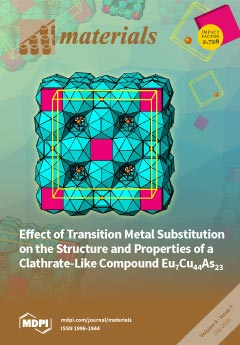Open AccessFeature PaperArticle
Solvent-Induced Polymorphism of Iron(II) Spin Crossover Complexes
by
Ivan Šalitroš 1,2,*, Olaf Fuhr 1,3 and Mario Ruben 1,4,*
1
Institut für Nanotechnologie, Karlsruher Institut für Technologie, Postfach 3640, Karlsruhe 76021, Germany
2
Faculty of Chemical and Food Technology, Institute of Inorganic Chemistry, Technology and Materials, Slovak University of Technology, Bratislava 812 37, Slovakia
3
Karlsruhe Nano Micro Facility (KNMF), Karlsruher Institut für Technologie, Postfach 3640, Karlsruhe 76021, Germany
4
Institute de Physique et Chimie de Matériaux de Strasbourg (IPCMS), CNRS-Université de Strasbourg, 23, rue du Loess BP 43, F-67034 Strasbourg cedex 2, France
Cited by 24 | Viewed by 6366
Abstract
Two new mononuclear iron(II) compounds (
1) and (
2) of the general formula [Fe(
L)
2](BF
4)
2·nCH
3CN (
L = 4-(2-bromoethyn-1-yl)-2,6-bis(pyrazol-1-yl)pyridine,
n = 1 for (
1) and
n = 2 for
[...] Read more.
Two new mononuclear iron(II) compounds (
1) and (
2) of the general formula [Fe(
L)
2](BF
4)
2·nCH
3CN (
L = 4-(2-bromoethyn-1-yl)-2,6-bis(pyrazol-1-yl)pyridine,
n = 1 for (
1) and
n = 2 for compound (
2)), were synthesized. The room temperature crystallization afforded concomitant formation of two different solvent analogues: compound (
1) exhibiting triclinic P-1 and compound (
2) monoclinic C2/c symmetry. Single-crystal X-ray studies confirmed the presence of the LS (low-spin) state for both compounds at 180 K and of the HS (high-spin) state for compound (
2) at 293 K, in full agreement with the magnetic investigations for both solvent polymorphs. Compound (
1) exhibits spin transition above 293 K followed by subsequent solvent liberation, while the spin transition of (
2) takes already place at 237 K. After complete solvent removal from the crystal lattice, compound (
1d) (the desolvated polymorph derived from (
1)) exhibits spin transition centered at 342 K accompanied by a thermal hysteresis loop, while the analogous compound (
2d) (the desolvated derivate of compound (
2)) remains blocked in the HS state over all the investigated temperature range.
Full article
►▼
Show Figures






